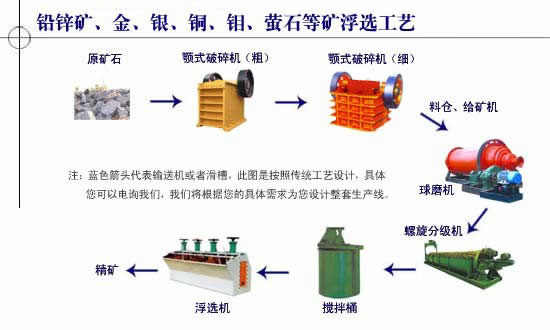Flotation Separation Process

Flotation production line in the basic flow is introduced
Flotation separation is one of the most important technological applications, but also very widely used.According to statistics, more than 90% of nonferrous metals mineral flotation process.In addition, also used in ferrous metals, precious metals and non-metallic mineral beneficiation, even to the water quality purification field in recent years.From the above according to the standard in the process design of flotation flow chart can clearly see the general mineral beneficiation process, flotation machine is an important device for flotation, pulp after sufficient aeration stirring, useful mineral enrichment, complete assignments flotation.Are important steps in the process of flotation reagents selection and operation, so as to achieve good beneficiation.Compared with other separation methods, the flotation dressing economic and reasonable, the effect is very good.Note: this process according to the standard process design, can be in accordance with the requirements of different customers production and optimization design.
Particles on its surface hydrophobic properties or after flotation reagents function to obtain hydrophobic properties, can be in liquid, gas or oil - water interface.Currently the most widely used is the froth flotation method.Ore after crushing and grinding various mineral dissociation into individual particles, and the grain size conform to the requirements of the flotation process.To the pulp after grinding, stir in all kinds of flotation reagents and harmonic with mineral grains, to expand the flotability of the difference between different mineral grains.Mixed slurry into the flotation tank, mixing gas.Mineral particles in the pulp and bubble contact, collision, flotability good ore grain of selective adhesion to bubbles and was carried up into mineralization of gas - liquid - solid three phase foam layer, the mechanical scrape or from pulp surface overflow, dehydration, drying into concentrate products again.Can't float gangue minerals such as grain, along with the pulp from the bottom of the flotation tank as tailings discharge products.Will be useless to mineral grain, useful mineral particles in the pulp, known as reverse flotation, such as rose quartz from iron ore, etc.
The froth flotation is suitable for the 0.5 mm to 5 microns of ore grain, specific depending on the mineral grain.Selected particle size less than 5 microns to needs special flotation method.Such as flocculation floatation is fine with flocculant useful mineral flocculant larger particles, condensed from gangue fine mud after floating to the coarse grain of gangue.Carrier flotation with particle size is suitable for flotation of the ore particles as the carrier, make fine ore grain adhesion on the carrier surface and then floatation separation.And fine ore grain together with oil for flotation oil gathering of flotation and emulsified flotation, and the use of high temperature metal mineral in the ore into metal chemical reaction after flotation separation flotation, etc.Using foam flotation recovery of the metal ions in aqueous solution, first using chemical method to precipitate or with ion exchange resin adsorption, then flotation sediment or resin particles.
NEXT:Is the last article
